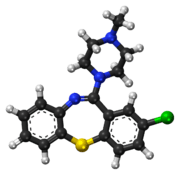Clotiapine
Clotiapine (Entumine) is an atypical antipsychotic[1] of the dibenzothiazepine chemical class.[2] It was first introduced in a few European countries (namely, Belgium, Italy, Spain and Switzerland), Argentina, Taiwan and Israel in 1970.[3]
 | |
 | |
| Clinical data | |
|---|---|
| Trade names | Etumina, Etumine, Entumin, Etomine, Entumine |
| AHFS/Drugs.com | International Drug Names |
| Routes of administration | Oral, Intravenous and Intramuscular |
| ATC code | |
| Legal status | |
| Legal status |
|
| Identifiers | |
| |
| CAS Number | |
| PubChem CID | |
| ChemSpider |
|
| UNII | |
| KEGG |
|
| ChEMBL | |
| CompTox Dashboard (EPA) | |
| ECHA InfoCard | 100.016.512 |
| Chemical and physical data | |
| Formula | C18H18ClN3S |
| Molar mass | 343.87 g·mol−1 |
| 3D model (JSmol) | |
| |
| |
| | |
Some sources regard clotiapine as a typical antipsychotic rather than atypical due to its high incidence of extrapyramidal side effects compared to the atypicals like clozapine and quetiapine, to which it is structurally related.[4] Despite its profile of a relatively high incidence of extrapyramidal side effects it has demonstrated efficacy in treatment-resistant individuals with schizophrenia according to a number of psychiatrists with clinical experience with it, some weak clinical evidence supports this view too.[3][4][5] A systematic review compared clotiapine with other antipsychotic drugs:
| Summary | ||||||||||||||||||||||||||||||||||||||||
|---|---|---|---|---|---|---|---|---|---|---|---|---|---|---|---|---|---|---|---|---|---|---|---|---|---|---|---|---|---|---|---|---|---|---|---|---|---|---|---|---|
| There was no evidence to support or refute the use of clotiapine in preference to other antipsychotic drug treatments for management of people with acute psychotic illness.[6] | ||||||||||||||||||||||||||||||||||||||||
| ||||||||||||||||||||||||||||||||||||||||
References
- Seminara G, Trassari V, Prestifilippo N, Chiavetta R, Calandra C (June 1993). "[Atypical tricyclic neuroleptics for treatment of schizophrenia. Clothiapine and clozapine]". Minerva Psichiatrica. 34 (2): 95–9. PMID 8105359.
- Schmutz J, Künzle F, Hunziker F, Gauch R (1967). "Über in 11-Stellung amino-substituierte Dibenzo[b,f]-1, 4-thiazepine und -oxazepine. 9. Mitteilung über siebengliedrige Heterocyclen". Helvetica Chimica Acta. 50: 245–254. doi:10.1002/hlca.19670500131.
- Lokshin, P; Kotler, M; Belmaker, RH (September 1997). "Clotiapine: Another forgotten treasure in psychiatry?". European Neuropsychopharmacology. 7 (Suppl 2): S217. doi:10.1016/S0924-977X(97)88712-3.
- Geller V, Gorzaltsan I, Shleifer T, Belmaker RH, Bersudsky Y (December 2005). "Clotiapine compared with chlorpromazine in chronic schizophrenia". Schizophrenia Research. 80 (2–3): 343–7. doi:10.1016/j.schres.2005.07.007. PMID 16126373.
- Van Wyk AJ, Marais GF (August 1971). "Chlorpromazine, clotiapine and thioridazine--a comparative clinical trial on Bantu psychotic patients" (PDF). South African Medical Journal = Suid-Afrikaanse Tydskrif vir Geneeskunde. 45 (34): 945–7. PMID 4939661.
- Carpenter S, Berk M, Rathbone J (October 2004). "Clotiapine for acute psychotic illnesses". The Cochrane Database of Systematic Reviews. 4 (4): CD002304. doi:10.1002/14651858.CD002304.pub2. PMID 15495032.
| Classes | |
|---|---|
| Antidepressants (TCAs and TeCAs) |
|
| Antihistamines |
|
| Antipsychotics |
|
| Anticonvulsants | |
| Others |
|